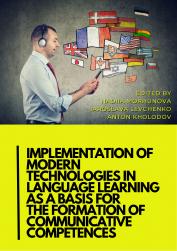Technological means of achieving second language learners’ idiomaticity as a way to build international communication competency
Keywords:
Educational technologies, foreign language communicative competence, information and communication technologies, foreign language, Ukrainian (for professional purposes), Ukrainian as a foreign language, interpersonal interaction, professional culture, professional communication, terminology, projective-recursive technologyAbstract
In the era of growing international contacts, Multilanguage communication skills are becoming of paramount importance. It is even more so for Ukraine that is going to experience a long period of post-war reconstruction with the help of our international partners. To do so, our country needs a wide range of specialists who should be competent not only in their own field of work and research but also in speaking a second language fluently and naturally. For getting such a vital skill, achieving a certain level of idiomaticity is exceptionally important for the second language learners, and nowadays, in times of sophisticated technologies and artificial intelligence, there exist so many means for the teacher to practice that.
In the study, second language learners’ idiomaticity is regarded as a complex speech characteristic, which involves speech naturalness and well-formedness. The variation of blended learning enables students to structure the discourse in the way native speakers do. It gives them a wide range of specific prepositional expressions, including some formal clichés and lexical chunks. At the same time idiomaticity tends to be the hardest to achieve when it comes to traditional learning techniques and models. Thus, the authors of the paper claim it is only the combination of traditional approaches to language training and the use of ICT and Internet resources that can balance the training process and allows second language learners to get not only the fluency they desire but also the naturalness, which idiomaticity can provide.

IMPLEMENTATION OF MODERN TECHNOLOGIES IN LANGUAGE LEARNING AS A BASIS FOR THE FORMATION OF COMMUNICATIVE COMPETENCES
Downloads
Pages
Published
Categories
License

This work is licensed under a Creative Commons Attribution-NonCommercial-NoDerivatives 4.0 International License.

